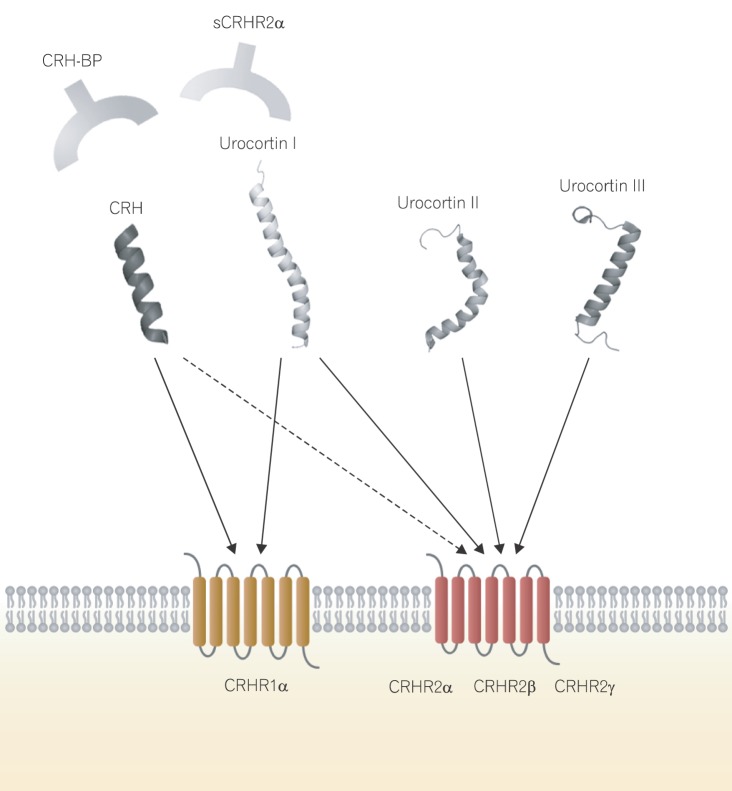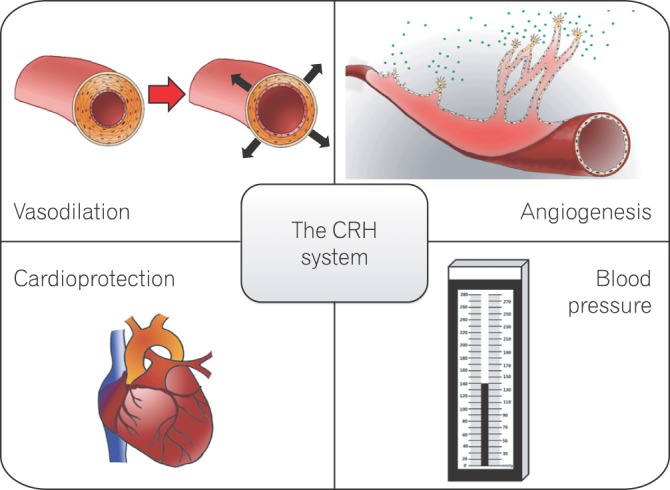Intest Res.
2014 Apr;12(2):96-102. 10.5217/ir.2014.12.2.96.
Corticotropin-releasing Hormone and Its Biological Diversity toward Angiogenesis
- Affiliations
-
- 1Department of Pharmacy, Pusan National University College of Pharmacy, Busan, Korea. eoim@pusan.ac.kr
- KMID: 2284893
- DOI: http://doi.org/10.5217/ir.2014.12.2.96
Abstract
- Angiogenesis is the formation of new blood vessels from existing ones and an underlying cause of numerous human diseases, including cancer and inflammation. A large body of evidence indicates that angiogenic inhibitors have therapeutic potential in the treatment of vascular diseases. However, detrimental side effects and low efficacy hinder their use in clinical practice. Members of the corticotropin-releasing hormone (CRH) family, which comprises CRH, urocortin I-III, and CRH receptors (CRHR) 1 and 2, are broadly expressed in the brain and peripheral tissues, including the intestine and cardiovascular system. The CRH family regulates stress-related responses through the hypothalamic-pituitary-adrenal axis. Therapeutic agents that target CRH family members offer a new approach to the treatment of various gastrointestinal disorders, including irritable bowel syndrome (IBS), inflammatory bowel disease (IBD), and colorectal cancer. Since the discovery that CRHR 2 has anti-angiogenic activity during postnatal development in mice, studies have focused on the role of the CRH system in the modulation of blood vessel formation and cardiovascular function. This review will outline the basic biological functions of the CRH family members and the implications for the development of novel anti-angiogenic therapies.
MeSH Terms
-
Angiogenesis Inhibitors
Animals
Axis, Cervical Vertebra
Biodiversity*
Blood Vessels
Brain
Cardiovascular System
Colorectal Neoplasms
Corticotropin-Releasing Hormone*
Humans
Inflammation
Inflammatory Bowel Diseases
Intestines
Irritable Bowel Syndrome
Mice
Receptors, Corticotropin-Releasing Hormone
Urocortins
Vascular Diseases
Angiogenesis Inhibitors
Corticotropin-Releasing Hormone
Receptors, Corticotropin-Releasing Hormone
Urocortins
Figure
Reference
-
1. Vale W, Spiess J, Rivier C, Rivier J. Characterization of a 41-residue ovine hypothalamic peptide that stimulates secretion of corticotropin and beta-endorphin. Science. 1981; 213:1394–1397. PMID: 6267699.2. Tache Y, Bonaz B. Corticotropin-releasing factor receptors and stress-related alterations of gut motor function. J Clin Invest. 2007; 117:33–40. PMID: 17200704.3. Lenz HJ, Burlage M, Raedler A, Greten H. Central nervous system effects of corticotropin-releasing factor on gastrointestinal transit in the rat. Gastroenterology. 1988; 94:598–602. PMID: 3257450.4. Lenz HJ, Raedler A, Greten H, Vale WW, Rivier JE. Stress-induced gastrointestinal secretory and motor responses in rats are mediated by endogenous corticotropin-releasing factor. Gastroenterology. 1988; 95:1510–1517. PMID: 2846402.5. Stengel A, Tache Y. Corticotropin-releasing factor signaling and visceral response to stress. Exp Biol Med (Maywood). 2010; 235:1168–1178. PMID: 20881321.6. Martinez V, Wang L, Rivier JE, Vale W, Tache Y. Differential actions of peripheral corticotropin-releasing factor (CRF), urocortin II, and urocortin III on gastric emptying and colonic transit in mice: role of CRF receptor subtypes 1 and 2. J Pharmacol Exp Ther. 2002; 301:611–617. PMID: 11961064.7. Im E, Rhee SH, Park YS, Fiocchi C, Tache Y, Pothoulakis C. Corticotropin-releasing hormone family of peptides regulates intestinal angiogenesis. Gastroenterology. 2010; 138:2457–2467. PMID: 20206175.8. Anton PM, Gay J, Mykoniatis A, et al. Corticotropin-releasing hormone (CRH) requirement in Clostridium difficile toxin A-mediated intestinal inflammation. Proc Natl Acad Sci U S A. 2004; 101:8503–8508. PMID: 15159534.9. Kokkotou E, Torres D, Moss AC, et al. Corticotropin-releasing hormone receptor 2-deficient mice have reduced intestinal inflammatory responses. J Immunol. 2006; 177:3355–3361. PMID: 16920976.10. Million M, Tache Y, Anton P. Susceptibility of Lewis and Fischer rats to stress-induced worsening of TNB-colitis: protective role of brain CRF. Am J Physiol. 1999; 276:G1027–G1036. PMID: 10198347.11. Agelaki S, Tsatsanis C, Gravanis A, Margioris AN. Corticotropin-releasing hormone augments proinflammatory cytokine production from macrophages in vitro and in lipopolysaccharideinduced endotoxin shock in mice. Infect Immun. 2002; 70:6068–6074. PMID: 12379683.12. Jackson JR, Seed MP, Kircher CH, Willoughby DA, Winkler JD. The codependence of angiogenesis and chronic inflammation. FASEB J. 1997; 11:457–465. PMID: 9194526.13. Vaughan J, Donaldson C, Bittencourt J, et al. Urocortin, a mammalian neuropeptide related to fish urotensin I and to corticotropin-releasing factor. Nature. 1995; 378:287–292. PMID: 7477349.14. Lewis K, Li C, Perrin MH, et al. Identification of urocortin III, an additional member of the corticotropin-releasing factor (CRF) family with high affinity for the CRF2 receptor. Proc Natl Acad Sci U S A. 2001; 98:7570–7575. PMID: 11416224.15. Reyes TM, Lewis K, Perrin MH, et al. Urocortin II: a member of the corticotropin-releasing factor (CRF) neuropeptide family that is selectively bound by type 2 CRF receptors. Proc Natl Acad Sci U S A. 2001; 98:2843–2848. PMID: 11226328.16. Lovejoy DA, Balment RJ. Evolution and physiology of the corticotropin-releasing factor (CRF) family of neuropeptides in vertebrates. Gen Comp Endocrinol. 1999; 115:1–22. PMID: 10375459.17. Hauger RL, Grigoriadis DE, Dallman MF, Plotsky PM, Vale WW, Dautzenberg FM. International Union of Pharmacology. XXXVI. Current status of the nomenclature for receptors for corticotropin-releasing factor and their ligands. Pharmacol Rev. 2003; 55:21–26. PMID: 12615952.18. Muglia L, Jacobson L, Dikkes P, Majzoub JA. Corticotropinreleasing hormone deficiency reveals major fetal but not adult glucocorticoid need. Nature. 1995; 373:427–432. PMID: 7830793.19. Vetter DE, Li C, Zhao L, et al. Urocortin-deficient mice show hearing impairment and increased anxiety-like behavior. Nat Genet. 2002; 31:363–369. PMID: 12091910.20. Bittencourt JC, Vaughan J, Arias C, Rissman RA, Vale WW, Sawchenko PE. Urocortin expression in rat brain: evidence against a pervasive relationship of urocortin-containing projections with targets bearing type 2 CRF receptors. J Comp Neurol. 1999; 415:285–312. PMID: 10553117.21. Hillhouse EW, Grammatopoulos DK. The molecular mechanisms underlying the regulation of the biological activity of corticotropin-releasing hormone receptors: implications for physiology and pathophysiology. Endocr Rev. 2006; 27:260–286. PMID: 16484629.22. Zmijewski MA, Slominski AT. Emerging role of alternative splicing of CRF1 receptor in CRF signaling. Acta Biochim Pol. 2010; 57:1–13. PMID: 20234885.23. Hsu SY, Hsueh AJ. Human stresscopin and stresscopin-related peptide are selective ligands for the type 2 corticotropin-releasing hormone receptor. Nat Med. 2001; 7:605–611. PMID: 11329063.24. Smith GW, Aubry JM, Dellu F, et al. Corticotropin releasing factor receptor 1-deficient mice display decreased anxiety, impaired stress response, and aberrant neuroendocrine development. Neuron. 1998; 20:1093–1102. PMID: 9655498.25. Bale TL, Contarino A, Smith GW, et al. Mice deficient for corticotropin-releasing hormone receptor-2 display anxiety-like behaviour and are hypersensitive to stress. Nat Genet. 2000; 24:410–414. PMID: 10742108.26. Nishimura E, Billestrup N, Perrin M, Vale W. Identification and characterization of a pituitary corticotropin-releasing factor binding protein by chemical cross-linking. J Biol Chem. 1987; 262:12893–12896. PMID: 2820956.27. Chen AM, Perrin MH, Digruccio MR, et al. A soluble mouse brain splice variant of type 2alpha corticotropin-releasing factor (CRF) receptor binds ligands and modulates their activity. Proc Natl Acad Sci U S A. 2005; 102:2620–2625. PMID: 15701705.28. Bale TL, Giordano FJ, Hickey RP, et al. Corticotropin-releasing factor receptor 2 is a tonic suppressor of vascularization. Proc Natl Acad Sci U S A. 2002; 99:7734–7739. PMID: 12032352.29. Bale TL, Giordano FJ, Vale WW. A new role for corticotropin-releasing factor receptor-2: suppression of vascularization. Trends Cardiovasc Med. 2003; 13:68–71. PMID: 12586442.30. Tsurumi Y, Murohara T, Krasinski K, et al. Reciprocal relation between VEGF and NO in the regulation of endothelial integrity. Nat Med. 1997; 3:879–886. PMID: 9256279.31. Arbiser JL, Karalis K, Viswanathan A, et al. Corticotropin-releasing hormone stimulates angiogenesis and epithelial tumor growth in the skin. J Invest Dermatol. 1999; 113:838–842. PMID: 10571742.32. Wang J, Xu Y, Zhu H, Zhang R, Zhang G, Li S. Urocortin's inhibition of tumor growth and angiogenesis in hepatocellular carcinoma via corticotrophin-releasing factor receptor 2. Cancer Invest. 2008; 26:359–368. PMID: 18443956.33. Tezval H, Jurk S, Atschekzei F, et al. Urocortin and corticotropinreleasing factor receptor 2 in human renal cell carcinoma: disruption of an endogenous inhibitor of angiogenesis and proliferation. World J Urol. 2009; 27:825–830. PMID: 19437022.34. Tezval H, Jurk S, Atschekzei F, Serth J, Kuczyk MA, Merseburger AS. The involvement of altered corticotropin releasing factor receptor 2 expression in prostate cancer due to alteration of antiangiogenic signaling pathways. Prostate. 2009; 69:443–448. PMID: 19058138.35. Hao Z, Huang Y, Cleman J, et al. Urocortin2 inhibits tumor growth via effects on vascularization and cell proliferation. Proc Natl Acad Sci U S A. 2008; 105:3939–3944. PMID: 18308934.36. Singh LK, Boucher W, Pang X, et al. Potent mast cell degranulation and vascular permeability triggered by urocortin through activation of corticotropin-releasing hormone receptors. J Pharmacol Exp Ther. 1999; 288:1349–1356. PMID: 10027877.37. Theoharides TC, Singh LK, Boucher W, et al. Corticotropinreleasing hormone induces skin mast cell degranulation and increased vascular permeability, a possible explanation for its proinflammatory effects. Endocrinology. 1998; 139:403–413. PMID: 9421440.38. Turnbull AV, Vale W, Rivier C. Urocortin, a corticotropin-releasing factor-related mammalian peptide, inhibits edema due to thermal injury in rats. Eur J Pharmacol. 1996; 303:213–216. PMID: 8813571.39. Inada Y, Ikeda K, Tojo K, Sakamoto M, Takada Y, Tajima N. Possible involvement of corticotropin-releasing factor receptor signaling on vascular inflammation. Peptides. 2009; 30:365–372. PMID: 19026699.40. Overton JM, Fisher LA. Differentiated hemodynamic responses to central versus peripheral administration of corticotropinreleasing factor in conscious rats. J Auton Nerv Syst. 1991; 35:43–51. PMID: 1940026.41. Jin R, Li MZ, Bing YH, et al. Intracerebroventricular injection of stresscopin-related peptide enhances cardiovascular function in conscious rats. Regul Pept. 2013; 186:7–11. PMID: 23850799.42. Brar BK, Jonassen AK, Egorina EM, et al. Urocortin-II and urocortin-III are cardioprotective against ischemia reperfusion injury: an essential endogenous cardioprotective role for corticotropin releasing factor receptor type 2 in the murine heart. Endocrinology. 2004; 145:24–35. PMID: 12970163.43. Brar BK, Jonassen AK, Stephanou A, et al. Urocortin protects against ischemic and reperfusion injury via a MAPK-dependent pathway. J Biol Chem. 2000; 275:8508–8514. PMID: 10722688.44. Barry SP, Lawrence KM, McCormick J, et al. New targets of urocortin-mediated cardioprotection. J Mol Endocrinol. 2010; 45:69–85. PMID: 20501665.45. Coste SC, Kesterson RA, Heldwein KA, et al. Abnormal adaptations to stress and impaired cardiovascular function in mice lacking corticotropin-releasing hormone receptor-2. Nat Genet. 2000; 24:403–409. PMID: 10742107.46. Jain V, Vedernikov YP, Saade GR, Chwalisz K, Garfield RE. Endothelium-dependent and -independent mechanisms of vasorelaxation by corticotropin-releasing factor in pregnant rat uterine artery. J Pharmacol Exp Ther. 1999; 288:407–413. PMID: 9918539.47. Lubomirov L, Gagov H, Petkova-Kirova P, Duridanova D, Kalentchuk VU, Schubert R. Urocortin relaxes rat tail arteries by a PKA-mediated reduction of the sensitivity of the contractile apparatus for calcium. Br J Pharmacol. 2001; 134:1564–1570. PMID: 11724764.48. Suri C, McClain J, Thurston G, et al. Increased vascularization in mice overexpressing angiopoietin-1. Science. 1998; 282:468–471. PMID: 9774272.49. Gamez I, Ryan RP, Reid LD, Routt SM, Hollister BA. Corticorelin acetate, a synthetic corticotropin-releasing factor with preclinical antitumor activity, alone and with bevacizumab, against human solid tumor models. Cancer Chemother Pharmacol. 2011; 67:1415–1422. PMID: 20809121.50. Pioszak AA, Parker NR, Suino-Powell K, Xu HE. Molecular recognition of corticotropin-releasing factor by its G-proteincoupled receptor CRFR1. J Biol Chem. 2008; 283:32900–32912. PMID: 18801728.51. Grace CR, Perrin MH, Cantle JP, Vale WW, Rivier JE, Riek R. Common and divergent structural features of a series of corticotropin releasing factor-related peptides. J Am Chem Soc. 2007; 129:16102–16114. PMID: 18052377.
- Full Text Links
- Actions
-
Cited
- CITED
-
- Close
- Share
- Similar articles
-
- Multi-facets of Corticotropin-releasing Factor in Modulating Inflammation and Angiogenesis
- Immunohistochemical study on the somatostatin and corticotropin-releasing factor neurons in the hypothalamus of the dog
- The Prediction of Preterm Labor : The Role of Corticotropin-Releasing Hormone in Amniotic Fluid
- Enhancement of Cell Migration by Corticotropin-Releasing Hormone (CRH) in Human Gastric Cancer Cell Line, MKN-28
- Inhibition of Cell Migration by Corticotropin-Releasing Hormone (CRH) in Human Natural Killer Cell Line, NK-92MI



